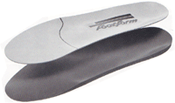
Orthotics are the necessary foundation when you're on your feet in a sport, wearing footwear. Whether you're in an athletic shoe, bike shoe, ski boot, water sandal, fishing waders, mountaineering boots, golf shoes, etc, shoe insert orthotics are key to top performance.
You can't see the orthotic, but it's in the shoe enhancing the performance of the athlete. The orthotic facilitates optimal foot position by providing a cradle contour for the foot's optimal position on the ground, guiding the foot to the strongest biomechanical function.
I began making custom orthotics in 1980 (in the Alpine Ski Industry) and have been learning and developing my expertise and shoe insole product ever since. Research involved in creating my custom footbeds is both observational and experiential. Not only do I make custom orthotics for a variety of athletes and skill levels, I also participate in sports so that I personally understand the demands an athlete makes on their body.
Epee Fencing is a sport I took up about 3 years ago, following my 14 year old daughter
Isabella Acosta Barna into the sport. Learning a new sport at any age is exciting mentally and physically. Isabella has inspired me to get off the sidelines and get on the fencing strip. Sharing the sport of epee fencing is a joy and a delightful bond with my teenage daughter.
Isabella is a natural fencer. At age 14 she won a Bronze in the under 20 age group (Junior) at the U.S. Fencing Summer Nationals 2008 in July, also earning her "A" rating as a fencer. Comparatively, I'm a duffer, but I workout hard with Isabella and she's training me well. This year I did win 3rd (a Bronze medal) in the Oregon State Games Veterans Epee division. The competition was held at the
Northwest Fencing Center in Beaverton, Oregon where Isabella is trained by the head coach, Sebastian Dos Santos.
Sports not only develop fitness, they are important for relationships of all types. My involvement with fencing has led me to volunteer at our local club, the
High Desert Fencing Club in Bend, Oregon. I'm the President and along with a Board of supportive parents we're building a non-profit club that develops young fencers in the Central Oregon area. It's a great place for kids and adults to connect through sports.
Here are some photos of Isabella and I fencing. The top photo is of me (on the left) fencing in a regional competition at the Northwest Fencing Center in Beaverton, Oregon. The second photo is of Isabella in a North America Cup competition. Of course, both Isabella and I are wearing
Footform orthotics!
The Northwest Fencing Center in Bend, Oregon is a 501C3 non-profit. All donations are tax-deductible. Contact me at my Footform Performance clinic phone 541-389-4547 to make a donation to the Fencing club. Donations pay for both infrastructure (rent, equipment, etc.) and for youth scholarships. Fencing skills are in demand at good universities and are a big plus on any young person's college application.











